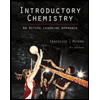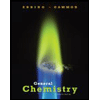
CHEMISTRY:CENTRAL SCIENCE-W/MOD.ACCESS
14th Edition
ISBN: 9780134809694
Author: Brown
Publisher: PEARSON
expand_more
expand_more
format_list_bulleted
Textbook Question
Chapter 6, Problem 102AE
Using the periodic table as a guide, write the condensed electron configuration and determine the number of unpaired electrons for the ground state of
- Br,
- Ga,
- Hf,
- Sb,
- Bi,
- Sg.
Expert Solution & Answer
Want to see the full answer?
Check out a sample textbook solution
Students have asked these similar questions
Hello I need homework help. Please focus on box 2 and 3, box 1 is correct.
Using first- and second-order integrated rate laws
At a certain temperature the rate of this reaction is second order in H3PO4 with a rate constant of 0.709M¯¯
2H3PO4 (aq) → P₂O5(aq)+3H₂O(aq)
-1
-1
·S
Round your answer to 2 significant digits.
Suppose a vessel contains H3PO4 at a concentration of 0.880M. Calculate how long it takes for the concentration of H3PO4 to decrease to 0.141M. You may
assume no other reaction is important.
x10
?
00.
18
무
Naming coordination compounds
Name these coordination compounds.
formula
[FeCl2 (CO)4] Cl
Na₂ [MnBr, (NH)₂]
4
[GCL (H,0),]C
name
Х
000
18
Ar
Chapter 6 Solutions
CHEMISTRY:CENTRAL SCIENCE-W/MOD.ACCESS
Ch. 6.1 - A source of electromagnetic radiation produces...Ch. 6.1 - Which type of visible light has a longer...Ch. 6.1 - Consider the following three statements: For any...Ch. 6.1 - A laser used in orthopedic spine surgery produces...Ch. 6.2 - Prob. 6.3.1PECh. 6.2 -
A laser emits light that has a frequency of 4.69...Ch. 6.3 - Prob. 6.4.1PECh. 6.3 -
For each of the following transitions, give the...Ch. 6.4 - Consider the following three moving objects: a...Ch. 6.4 - Calculate the velocity of a neutron whose de...
Ch. 6.5 - An orbital has n = 4 and ml = 0, 1, 2, 3 -3, - 2,...Ch. 6.5 -
What is the designation for the subshell with = 5...Ch. 6.8 - How many of the elements in the second row of the...Ch. 6.8 - Write the electron configuration for silicon,...Ch. 6.9 - A certain atom has an ns2np2electron configuration...Ch. 6.9 -
Which group of elements is characterized by an...Ch. 6.9 -
A certain atom has a [noble gas]5s24d105p4...Ch. 6.9 - Prob. 6.9.2PECh. 6 - In this chapter, we have learned about the...Ch. 6 - The speed of sound in dry air at 20°C is 343 m/s...Ch. 6 -
6.2 A popular kitchen appliance produces...Ch. 6 - 6.3 The following diagrams represent two...Ch. 6 -
6.4 Stars do not all have the same temperature....Ch. 6 - 6 5 The familiar phenomenon of a rainbow results...Ch. 6 -
6.7 A certain quantum mechanical system has the...Ch. 6 - Consider the three electronic transitions in a...Ch. 6 - Prob. 8ECh. 6 -
6.9 The contour representation of one of the...Ch. 6 -
6.10 The accompanying drawing shows a contour...Ch. 6 -
8.11 Four possible electron configurations for a...Ch. 6 -
6.12 State where in the periodic table these...Ch. 6 - Prob. 13ECh. 6 -
6.14
a What is the relationship between the...Ch. 6 - Label each of the following statements as true or...Ch. 6 - Determine which of the following statements are...Ch. 6 - Arrange the following kinds of electromagnetic...Ch. 6 - List the following types of electromagnetic...Ch. 6 - What is the frequency of radiation that has a...Ch. 6 - What is the frequency of radiation whose...Ch. 6 - A laser pointer used in a lecture hall emits light...Ch. 6 - It is possible to convert radiant energy into...Ch. 6 - If human height were quantized in 1-foot...Ch. 6 - Einstein's 1905 paper on the photoelectric effect...Ch. 6 - Calculate the energy of a photon of...Ch. 6 - Prob. 26ECh. 6 - Prob. 27ECh. 6 - An AM radio station broadcasts at 1010 kHz, and...Ch. 6 - One type of sunburn occurs on exposure to UV light...Ch. 6 - Prob. 30ECh. 6 - Prob. 31ECh. 6 - A stellar object is emitting radiation at 3.55 mm....Ch. 6 - Molybdenum metal must absorb radiation with a...Ch. 6 - Titanium metal requires a photon with a minimum...Ch. 6 - Prob. 35ECh. 6 - Classify each of the following statements as...Ch. 6 - Prob. 37ECh. 6 -
6 38 Indicate whether energy is emitted or...Ch. 6 - Using Equation 6.5. calculate the energy of an...Ch. 6 - Prob. 40ECh. 6 - The visible emission lines observed by Balmer all...Ch. 6 - Prob. 42ECh. 6 - Prob. 43ECh. 6 - The hydrogen atom can absorb light of wavelength...Ch. 6 - Prob. 45ECh. 6 - Prob. 46ECh. 6 - Use the de Brogue relationship to determine the...Ch. 6 - Prob. 48ECh. 6 - Neutron diffraction is an important technique for...Ch. 6 - The electron microscope has been widely used to...Ch. 6 - Using Heisenberg's uncertainty principle,...Ch. 6 - Prob. 52ECh. 6 - Classify the following statements as either true...Ch. 6 - 0 1 2 3 4 5 6 7 8 9 10 Distance from the nucleus,...Ch. 6 - Prob. 55ECh. 6 - Prob. 56ECh. 6 - Prob. 57ECh. 6 - Give the values for n, I,and mlfor each orbital in...Ch. 6 - Prob. 59ECh. 6 - Prob. 60ECh. 6 - Which of the following represent impossible...Ch. 6 - For the table that follows, write which orbital...Ch. 6 - Sketch the shape and orientation of the following...Ch. 6 - Prob. 64ECh. 6 - Prob. 65ECh. 6 - Prob. 66ECh. 6 - Prob. 67ECh. 6 - Prob. 68ECh. 6 - Two possible electron configurations for an Li...Ch. 6 -
6.70 An experiment called the Stern—Gerlach...Ch. 6 - Prob. 71ECh. 6 - Prob. 72ECh. 6 - What are "valence electrons"? What are "core...Ch. 6 - For each element, indicate the number of valence...Ch. 6 - Write the condensed electron configurations for...Ch. 6 - Write the condensed electron configurations for...Ch. 6 - Identify the specific element that corresponds to...Ch. 6 - Identify the group of elements that corresponds to...Ch. 6 - The following do not represent valid ground-state...Ch. 6 - Prob. 80ECh. 6 - Prob. 81AECh. 6 - Prob. 82AECh. 6 - Prob. 83AECh. 6 - Prob. 84AECh. 6 - Prob. 85AECh. 6 - Prob. 86AECh. 6 - Prob. 87AECh. 6 - In an experiment to study the photoelectric...Ch. 6 - Prob. 89AECh. 6 - Prob. 90AECh. 6 - Prob. 91AECh. 6 - Prob. 92AECh. 6 - Prob. 93AECh. 6 - Prob. 94AECh. 6 - Prob. 95AECh. 6 - Prob. 96AECh. 6 - Prob. 97AECh. 6 - Prob. 98AECh. 6 - Prob. 99AECh. 6 - [6.100] The Chemistry and Life box in Section 6.7...Ch. 6 - Prob. 101AECh. 6 - Using the periodic table as a guide, write the...Ch. 6 - Prob. 103AECh. 6 - [6.104] In the experiment shown schematically...Ch. 6 - Microwave ovens use microwave radiation to heat...Ch. 6 - Prob. 106IECh. 6 - The discovery of hafnium, element number 72,...Ch. 6 - Account for formation of the following series of...Ch. 6 - Prob. 109IECh. 6 - The two most common isotopes of uranium are 235U...
Knowledge Booster
Learn more about
Need a deep-dive on the concept behind this application? Look no further. Learn more about this topic, chemistry and related others by exploring similar questions and additional content below.Similar questions
- Why does this phenomenon of optically active occur? As you observed in the lab, why do the various compounds alter the results? What causes the differences? How do you know these molecules are all optically active, if they are? How does the concentration, purity, and identity of the substance effect the results? What must occur for the phenomenon to be observed?arrow_forwardDeducing a rate law from the change in concentration over time A chemistry graduate student is studying the rate of this reaction: 2NH3 (g) → N2 (g) +3H₂ (g) She fills a reaction vessel with NH3 and measures its concentration as the reaction proceeds: ? time (minutes) [NH3] 0 1.00M 1.0 0.571M 2.0 0.400 M 3.0 0.307M 4.0 0.250M Use this data to answer the following questions. Write the rate law for this reaction. rate k ☐ x10 Calculate the value of the rate constant k. k = ☐ Round your answer to 2 significant digits. Also be sure your answer has the correct unit symbol. G 000 18 Ar 。arrow_forwardWriting the rate law implied by a simple mechanism Suppose the formation of dinitrogen pentoxide proceeds by the following mechanism: step elementary reaction - 1 NO2(g) + O2(g) → NO(g) + O2(g) 2 NO3(g) + NO2(g) → N₂O(g) rate constant k₁ k₂ Suppose also k₁ «k2. That is, the first step is much slower than the second. Write the balanced chemical equation for the overall chemical reaction: Write the experimentally- observable rate law for the overall chemical reaction. Note: your answer should not contain the concentrations of any intermediates. ☐ rate = ☐ Express the rate constant k for the overall chemical reaction in terms of K1, K2, and (if necessary) the rate constants k-1 and K-2 for the reverse of the two elementary reactions in the mechanism. k = ☐ Х 5 olo 18 Ararrow_forward
- 18. A 10.2g piece of coal (carbon) is combusted completely beneath a calorimeter containing 800.0 mL of water. The initial temp of the water was 20.0°C, and the final temp was 62.7°C. Assuming complete transfer of heat from the carbon to the water, what is the molar enthalpy of combustion of carbon?arrow_forwardpls help asap on all.arrow_forwardpls help asap on all.arrow_forward
- Use the reaction coordinate graph below to answer questions 13-15: 13. Which step is the rate determining step? a. C→ E b. E→ G C. A → C d. Not enough information 14. The overall reaction: a. is exothermic b. is endothermic C. has no change in energy Energy d. not enough information 15. The activation energy for the overall reaction would be equal to: a. Ꭰ A b. F C. B d. B + D + F B 0 D E Reaction coordinate Garrow_forwardpls help asap on all.arrow_forwardpls help asap on all.arrow_forward
arrow_back_ios
SEE MORE QUESTIONS
arrow_forward_ios
Recommended textbooks for you
 Introductory Chemistry: An Active Learning Approa...ChemistryISBN:9781305079250Author:Mark S. Cracolice, Ed PetersPublisher:Cengage Learning
Introductory Chemistry: An Active Learning Approa...ChemistryISBN:9781305079250Author:Mark S. Cracolice, Ed PetersPublisher:Cengage Learning Chemistry: The Molecular ScienceChemistryISBN:9781285199047Author:John W. Moore, Conrad L. StanitskiPublisher:Cengage Learning
Chemistry: The Molecular ScienceChemistryISBN:9781285199047Author:John W. Moore, Conrad L. StanitskiPublisher:Cengage Learning General Chemistry - Standalone book (MindTap Cour...ChemistryISBN:9781305580343Author:Steven D. Gammon, Ebbing, Darrell Ebbing, Steven D., Darrell; Gammon, Darrell Ebbing; Steven D. Gammon, Darrell D.; Gammon, Ebbing; Steven D. Gammon; DarrellPublisher:Cengage Learning
General Chemistry - Standalone book (MindTap Cour...ChemistryISBN:9781305580343Author:Steven D. Gammon, Ebbing, Darrell Ebbing, Steven D., Darrell; Gammon, Darrell Ebbing; Steven D. Gammon, Darrell D.; Gammon, Ebbing; Steven D. Gammon; DarrellPublisher:Cengage Learning Chemistry: Principles and PracticeChemistryISBN:9780534420123Author:Daniel L. Reger, Scott R. Goode, David W. Ball, Edward MercerPublisher:Cengage Learning
Chemistry: Principles and PracticeChemistryISBN:9780534420123Author:Daniel L. Reger, Scott R. Goode, David W. Ball, Edward MercerPublisher:Cengage Learning Chemistry: Principles and ReactionsChemistryISBN:9781305079373Author:William L. Masterton, Cecile N. HurleyPublisher:Cengage Learning
Chemistry: Principles and ReactionsChemistryISBN:9781305079373Author:William L. Masterton, Cecile N. HurleyPublisher:Cengage Learning

Introductory Chemistry: An Active Learning Approa...
Chemistry
ISBN:9781305079250
Author:Mark S. Cracolice, Ed Peters
Publisher:Cengage Learning

Chemistry: The Molecular Science
Chemistry
ISBN:9781285199047
Author:John W. Moore, Conrad L. Stanitski
Publisher:Cengage Learning

General Chemistry - Standalone book (MindTap Cour...
Chemistry
ISBN:9781305580343
Author:Steven D. Gammon, Ebbing, Darrell Ebbing, Steven D., Darrell; Gammon, Darrell Ebbing; Steven D. Gammon, Darrell D.; Gammon, Ebbing; Steven D. Gammon; Darrell
Publisher:Cengage Learning

Chemistry: Principles and Practice
Chemistry
ISBN:9780534420123
Author:Daniel L. Reger, Scott R. Goode, David W. Ball, Edward Mercer
Publisher:Cengage Learning

Chemistry: Principles and Reactions
Chemistry
ISBN:9781305079373
Author:William L. Masterton, Cecile N. Hurley
Publisher:Cengage Learning

Quantum Numbers, Atomic Orbitals, and Electron Configurations; Author: Professor Dave Explains;https://www.youtube.com/watch?v=Aoi4j8es4gQ;License: Standard YouTube License, CC-BY
QUANTUM MECHANICAL MODEL/Atomic Structure-21E; Author: H to O Chemistry;https://www.youtube.com/watch?v=mYHNUy5hPQE;License: Standard YouTube License, CC-BY